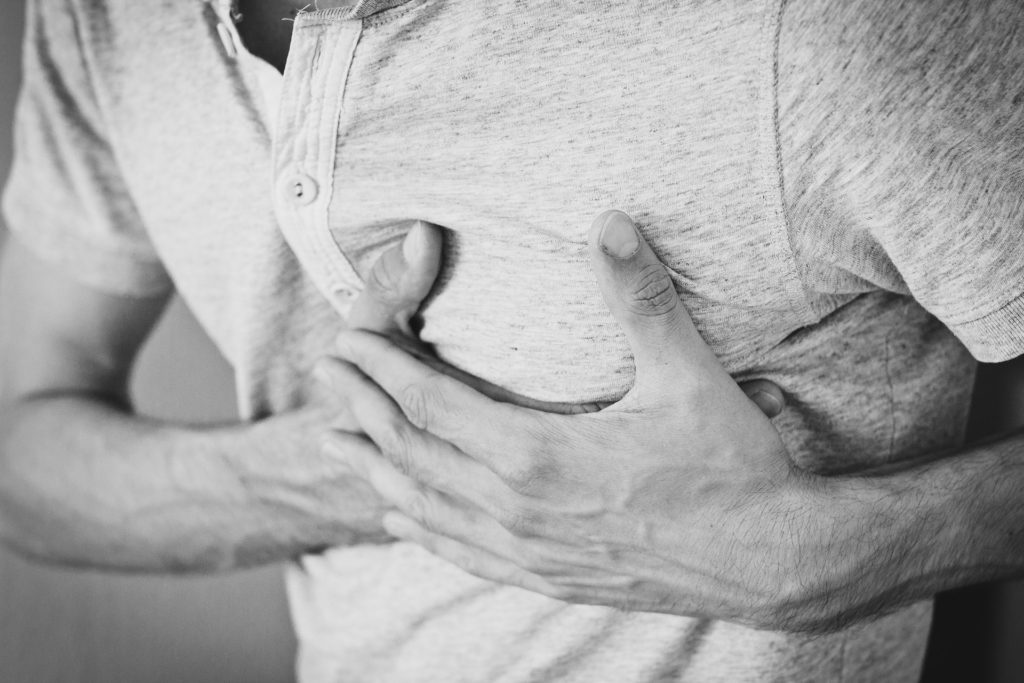
Heart attacks and panic attacks share many of the same symptoms, including excessive sweating, chest pain, nausea, vomiting, and uneven breathing. The fact that heart attacks can cause your anxiety level to skyrocket only makes it more difficult to determine whether you’re having a panic attack or heart attack. However, despite the fact that they share many similarities, you can learn how to effectively distinguish between the two.
Signs of a Heart Attack
People who have had a heart attack often describe the pain as constricting. The pain tends to be located in the center of the chest and can radiate along the back and left arm. Some people have also reported that the pain can spread to the jaw, teeth, and neck area. During a heart attack, the pain will continue to intensify and may last for more than five minutes. It will not affect your breathing.
The prickly feeling commonly experienced is usually restricted to the left arm and is often accompanied by sweat, vomiting, nausea, or intense cold.
At the peak of a heart attack, a person will often experience an increased level of fear, which is usually concentrated on the pain in their chest. The intensity of the episode will make a person feel as though they’re going to die.
If you experience any of these symptoms for more than five minutes, call for an ambulance.
Signs of a Panic Attack
Panic attacks can occur in the most ordinary of circumstances, despite the widespread misconception. The symptoms associated with panic attacks usually peak after ten to fifteen minutes.
When a panic attack occurs, the pain is usually concentrated in the chest, causing erratic breathing.
The numbness and prickly feeling that takes place usually isn’t restricted to one arm and can appear in the fingers, legs, and both arms.
During an attack, a person will experience irrational fears such as they’re going crazy or suffocating.
If you can’t determine whether you’re having a panic attack or a heart attack, seek medical treatment immediately. Waiting around for the episode to pass, especially if you’ve never had a panic attack before, is not the best solution. If it turns out that you’re actually having a heart attack, you can die without medical attention. Even a lack of medical support during a panic attack can lead to worsening symptoms and may even lead to a heart attack. Proper medical care and ongoing treatment can help to improve your quality of life and lessen the frequency of the panic attacks.
For more information on natural ways to manage panic attacks and associated symptoms, click here to read our review on the 60 Second Panic Solution.
Why Do Panic Attacks Occur?
Panic attacks can occur spontaneously, or they can be triggered by a stressful event. However, a panic attack isn’t the same as a heart attack because it’s not considered a life-threatening condition. But if you don’t have a history of panic attacks it’s important to seek medical attention right away to rule out a heart attack and to make arrangements for ongoing medical attention in order to learn how to prevent panic attacks from occurring in the future.
Panic disorder is diagnosed in people who are preoccupied with the fear of panic attacks and those with a history of panic attacks.
Treatment for panic disorder often involves determining what triggers attacks. Ongoing treatment is not only important to prevent future episodes, but research has shown that people who have panic disorder under the age of fifty have an increased risk of suffering a heart attack.
Additionally, if left untreated, over time, panic attack symptoms can be unmanageable, the panic attacks may last longer, and they may become more frequent. They can occur at any time of the day or night, or you can even be at risk of having a panic attack while driving.
Once you have seen your primary doctor, speak with a therapist to learn more about how to prevent panic attack and manage your anxiety. You can also learn about relaxation techniques you can use when having a panic attack, and lifestyle changes you need to make in order to reduce your chances of a panic attack in the future. Over time, with the right changes, panic attacks will become less frequent and may disappear altogether.
The Root Cause of Heart Attacks

Over time, plaque builds up in the arteries, narrowing the channels that the blood flows through. Plaque consists of cholesterol buildup. It can also harden or calcify. If an artery narrows because of the plaque buildup, it will be unable to supply enough blood to the heart when it becomes stressed. Just like your legs hurt when you run too fast, the heart will ache and begin to hurt if it doesn’t get enough blood. This type of pain is referred to as angina. If the plaque in the artery ruptures, a clot forms in the blood vessel, working as a dam, blocking blood flow. When the heart loses blood supply completely, the muscle will die. This is called a heart attack.
Risk factors for a heart attack include the following:
- A family history of heart attacks
- Cigarette smoking
- High cholesterol
- High blood pressure
- Diabetes
Drug use, alcohol abuse, eating disorders, and a sedentary lifestyle can also increase your risk.
Like panic attack treatment, major lifestyle changes are necessary. As a heart attack survivor, you will need to make changes to your diet, cut out caffeine, processed foods, and quit smoking or drinking alcohol.
If you have had a heart attack, you may also need to take medication that will help to control your blood pressure and lower your cholesterol level.
As you can see, it can be hard to determine whether you’re having a heart attack or panic attack, especially when it’s happening. If in doubt, have someone call 911. With both conditions, ongoing medical treatment is the best approach to ensure your future health and to break the cycle, so you can move forward and lead a healthier and happier life.